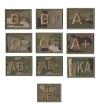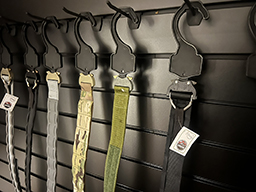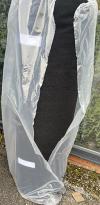Guide to Airborne Webbing / Commanders Webbing / Tailored Webbing Used by the British Military

Airborne Webbing / Commanders Webbing as used by members of the British Military
Airborne Webbing or Commanders Webbing describes a popular design of load carriage gear that is worn on the person.
The type of kit that it holds includes Magazines, Waterbottle, rations, cooker, cord, first aid kit and lots other items depending on what your role is.
Even though this type of webbing is often referred to as Airborne Webbing it is not just Paratroopers who use it, although its common to them using it and other members of the infantry its also common for most switched-on members of the military to own a set.
The term Airborne Webbing or Commanders webbing has become a commonly used description for a single unit webbing set with an integral hip pad. We recognize that this terminology may not accurately reflect the item, but it has become the simplest way to describe it for those unfamiliar with the product.
This type of webbing is also referred to as Tailored webbing and belt kit, each manufacturer seems to give it, its own name.
The Airborne Webbing is equipped with a hip pad that is jointed and padded with closed cell foam to protect and provide cushioning to the soldier. The pouches are directly sewn onto the hip pad, which enhances stability and comfort. Most decent sets of Commanders Webbing have been meticulously designed and manufactured in the UK to meet the highest standards.
By utilizing fixed pouches, the belt kit is adjustable to fit users with smaller waist sizes. Through the innovative design methods, manufacturers are able to maintain the same number of required pouches and attach them to pads of varying lengths, resulting in a customized and comfortable fit for the user.
This means that if you have a small waist size you can still have enough pouches, the kits fir all genders and its not uncommon to see a female with Airborne Webbing. And some companies actually manufacture a very cheap version outside the UK for cadets.
It is advisable if you are buying Tailored webbing and are in the regular military to buy a set that is UK manufactured.
Having the pouches sewn together minimizes bouncing of the belt kit. When all pouches are full, they stabilize against each other, forming a solid structure that doesn't bounce or sway.
Most manufacturers will offer a choice of Buckles, these include a Duraflex Side Release, AustriAlpin Cobra Buckle or even a Roll Pin Belt. Some will offer an AustriAlpin GT Cobra Buckle.
Its also possible to have the webbing manufactured to your own design, a UK Manufacturer like UK Outdoor Manufacturing (UKOM) will make a set of webbing to any design you want and they all come with lifetime guarantees. That can be the benefit of using UK Manufacturers.
Below is just a quick guide on why its important to have good webbing.
Having good equipment for carrying ammunition, magazines, water, and food is critical for a soldier in combat. The ability to sustain oneself with food and water while carrying necessary equipment can be the difference between life and death on the battlefield. In this guide, we will discuss the reasons why good equipment is essential for carrying ammunition, magazines, water, and food into battle.
Reliability
Good equipment is reliable and durable. Soldiers need equipment that will withstand the rigors of combat and continue to function properly. Equipment that fails can put a soldier's life at risk, especially when carrying essential supplies such as ammunition, magazines, water, and food. Good equipment is designed and tested to perform in harsh environments and extreme conditions.
Efficiency
Efficiency is critical in combat situations. Soldiers need to be able to quickly reload, resupply ammunition, hydrate, and nourish themselves without having to fumble with poorly designed or inadequate equipment. Good equipment is designed with efficiency in mind, allowing soldiers to quickly access and use their ammunition, magazines, water, and food.
Comfort
Carrying ammunition, magazines, water, and food can be heavy and uncomfortable. Good equipment is designed to distribute the weight evenly and comfortably, reducing fatigue and strain on the soldier. This allows soldiers to focus on their mission and not on their discomfort.
Adaptability
Good equipment is adaptable to different situations and missions. Soldiers need equipment that can be adjusted and modified to meet their specific needs. For example, a soldier may need to carry additional water or food for a particular mission or may need to modify their equipment for different environmental conditions.
Confidence
Finally, good equipment gives soldiers confidence. Knowing that they have reliable, efficient, and safe equipment to carry their essential supplies can boost a soldier's morale and confidence in their ability to complete their mission successfully.
In conclusion, having good equipment to carry ammunition, magazines, water, and food is critical for a soldier in combat. It provides reliability, efficiency, comfort, adaptability, safety, and confidence to soldiers in combat situations. Investing in good equipment is a wise decision for any soldier or military unit.
There are a lot of courses in the British Military were the use of Commanders Webbing is important and regiments past and present have worn and are still wearing Tailored webbing in training, on courses and operationally today. Even though Shooters belts and Virtus is common place the Airborne Webbing, Tailored Webbing , Commanders webbing or belt is still worn.
RAF Regiment, Royal Marines, Household Division, Life Guards, Blues and Royals, Grenadier Guards, Coldstream Guards, Scots Guards, Irish Guards, Parachute Regiment, Rifles, Royal Gurkha Rifles, Mercian Regiment, Yorkshire Regiment, Royal Welsh, Royal Irish Regiment, Royal Scots Borderers, 1st Battalion Royal Regiment of Scotland, Royal Highland Fusiliers, 2nd Battalion Royal Regiment of Scotland, Princess of Wales's Royal Regiment, Royal Regiment of Fusiliers, Royal Anglian Regiment, Light Infantry, Duke of Lancaster's Regiment, Devonshire and Dorset Regiment, Duke of Wellington's Regiment, King's Own Scottish Borderers, Royal Regiment of Scotland, Queen's Own Yeomanry, Royal Yeomanry, Honourable Artillery Company, Royal Wessex Yeomanry, Royal Lancers, King's Royal Hussars, Royal Tank Regiment, Royal Dragoon Guards, Household Cavalry Regiment, Royal Horse Artillery, Royal Artillery, Royal Engineers, Royal Corps of Signals, Intelligence Corps, Army Air Corps, Royal Army Chaplains' Department, Royal Logistic Corps, Royal Army Medical Corps, Royal Electrical and Mechanical Engineers, Adjutant General's Corps, Royal Military Police, Small Arms School Corps, Royal Army Dental Corps, General Service Corps.












